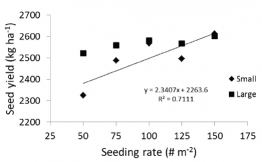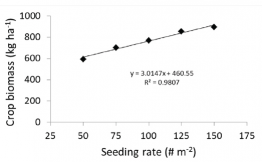Consider seed size when targeting optimum plant stand
Key result: Seeding rates should be established based on 1,000-seed weight, using an on-line seeding rate calculator or on-line apps.
Project title, Principal investigator: “Seed size and seeding rate effects on canola yield and quality,” Neil Harker, Agriculture and Agri-Food Canada Lacombe
Funding: Alberta Canola, MCGA, SaskCanola, CCC, AAFC, GF2
Recent surveys indicate that approximately half of all western Canadian canola growers have crop densities of less than 40 plants per square metre (about 4 plants per square foot), yet optimal, consistent yields require a minimum of 50 plants per square metre.
Adding to stand establishment challenges is that, in recent years, canola seed size has increased substantially. Seed weights greater than 6 g per 1,000 seeds are not uncommon. Large seed means a lower number of seeds per square metre are planted if seeding rate is based just on pounds per acre, and this approach could run the risk of less than 50 plants per square metre.
A three-year study investigated the influence of seed size on seedling emergence, and canola yield and quality. In 2013, direct-seeded experiments were conducted at nine western Canada locations. Four canola seed sizes (1,000-seed weights ranging from 4.0 to 5.7 g) and one un-sized treatment (4.4 g average) were seeded at two rates (75 and 150 seeds per square metre).
At the time of research, the largest seed available wasn’t representative of the largest seed size available in the marketplace. In 2014 and 2015, two seed sizes were compared at sixteen western Canadian sites; averaging 3.4 g
for small seed and 5.2 g for the large seed and five seeding rates (50, 75, 100, 125 or 150 seeds per square metre).
Improved crop growth
In 2013, higher seeding rates led to better canola emergence and stubble density at harvest, but did not result in higher yield. Higher seeding rates also increased early crop biomass, increased weights and seed oil content of harvested seed, and reduced days to start of flowering and days to crop maturity.
In 2014 and 2015, smaller seed had improved canola yield at higher seeding rates, but the same response did not occur for the larger seed lot. Increasing seeding rates also increased crop density, plant mortality, crop biomass and seed oil content and decreased days to start of flowering, days to end of flowering, days to maturity, per cent green seed and seed protein content.
Using the larger seed lot resulted in increased early crop growth and 1,000-seed weights but did not have an effect on canola emergence, yield or seed quality in 2013. In 2014 and 2015, the larger canola seeds increased crop density and crop growth and decreased plant mortality, days to start of flowering, days to end of flowering, days to maturity and per cent green seed. Seed size did not influence yield, seed oil content or seed protein content.


(2014-15 results). For large seed, seeding rate regression effect was not significant.
Conclusions
Given current trends for increased seed size, and the fact that canola seed costs are traditionally based on weight rather than seed number, it is useful to know that, in this trial, larger versus smaller seed could increase crop density and decrease plant mortality, days to flowering, days to end of flowering and days to maturity. In western Canada, earlier flowering and maturity are advantageous for optimum canola yields because high temperature yield reductions are less likely earlier in the growing season.
The larger seed also increased early season growth, which favours crop competition with weeds and less reliance on herbicides. Furthermore, planting the larger seed lot led to lower levels of green seed than small seed, and therefore created opportunities for higher canola grades and profits.
Growers should note that the largest seed lot available at the time of research wasn’t as large as is available in the marketplace. When choosing a canola seeding rate, growers should continue to focus on their target plant density which is affected by seed size, seeding rate and seed survival.




